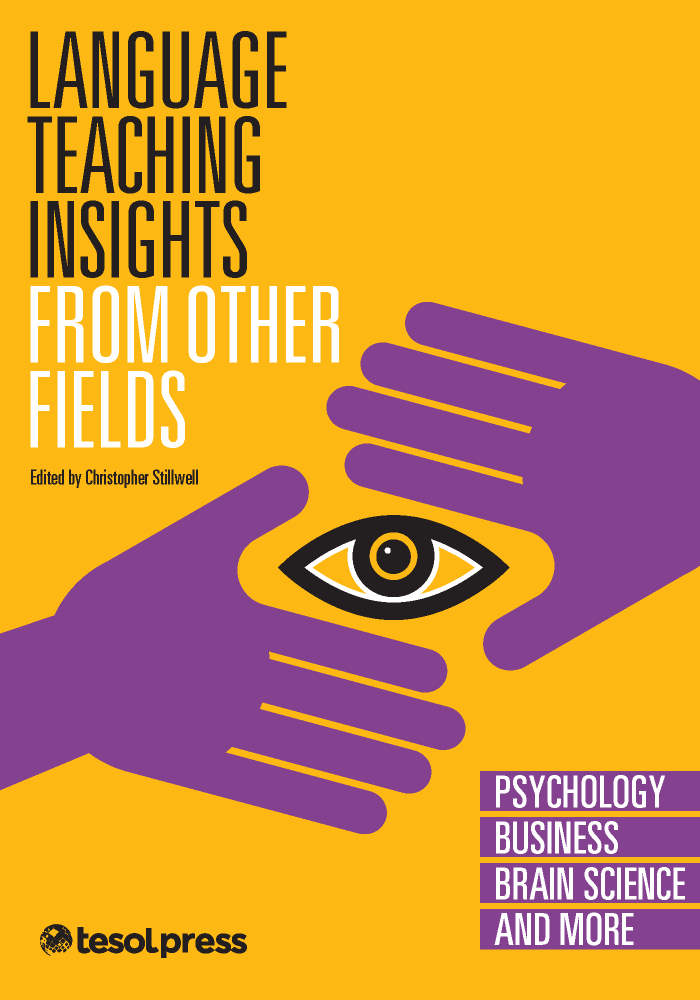FREE CHAPTER: Language Teaching Insights From Other Fields (Coming Soon from TESOL Press)
Edited by Christopher Stillwell
 Chapter 2: How Would a TV Commercial Producer Make Lessons as Memorable as an Ad?
Chapter 2: How Would a TV Commercial Producer Make Lessons as Memorable as an Ad?
by Wendy Hendrickson
from Language Teaching Insights From Other Fields: Psychology, Business, Brain Science, and More, coming soon from TESOL Press.
What makes one lesson such a knowledge-transfer triumph, while others seem to dwindle quickly or even die upon student contact? Using a story to carry your message can make the difference between success and failure. Stories get the brain’s attention, keep it coming back for more, and eventually result in independent use of the knowledge. The challenge for both commercial producers and teachers lies in knowing how to choose the right story—and how to do it well.
A COMMERCIAL PRODUCER’S TIPS FOR LANGUAGE TEACHERS
When I worked in commercial production, I developed commercials and campaigns for local businesses, and it was my job to gather information from a business, get a feel for who the company was, and then create a message that would focus on what the company was about and wanted to accomplish. This core message needed to be remembered and acted upon. Your goal for a teacher is the same as it is for any commercial producer: know what the core message is, plant it into the minds of your audience, and have them act on it. As a teacher, I now use the same skills that I employed when I made those commercials to produce language skills in students.
Commercial producers and marketers are always analyzing successful commercials so that they can imitate their success. Two books that are popular with my friends still working in the field are Thinking, Fast and Slow (Kahneman, 2011) and Made to Stick (Heath & Heath, 2007). Both books shed light on why successful commercials work and why the “story” told in each commercial is the key. These books have given me a greater understanding of why I’ve had success with using stories in the classroom. The examples in the books explain how a story touches us and changes us, and therefore is remembered and often acted upon. Marketers know how to put this research into action; my belief is that language teachers can do it, too.
Tip 1: Identify your core message and put it in a story.
First you need to get a grasp on how a commercial producer or marketing professional uncovers a company’s core message and relays it as a story in a commercial. For a little perspective on the process, I called Gretchen Everett—the marketing director for Taco Time Northwest—to ask about the fast food chain’s recent change in commercials. From the beginning the founder of Taco Time had a passion for fresh and healthy ingredients. So the core message of the commercials was fast food that is fresh and healthy. This set the company apart from other fast food chains. Its mascot, Ned the talking cactus, poked fun at Taco Time for not really being fast food.
But as more and more national fast food chains (such as Subway) recognized that “healthy and fast” sold well, they started hopping on the “fast food can be healthy” bandwagon. Gretchen and her team realized that Taco Time was in danger of losing its distinctive identity in the market. Its core message needed a tweak. Taco Time worked to set itself apart from the national fast food companies once again. The company connected itself to an even greater idea. “Time and vision came together for us as the buy-local movement, anti-large corporation movement surfaced,” Gretchen passionately states (personal communication, June 28, 2012).
Taco Time’s pièce de résistance was its decision to become the locally owned company who buys locally. It now provides customers with the opportunity to be part of a noble cause in spades: It uses locally grown ingredients and buys other items from local suppliers. “We are fresh, healthy, and local to the core,” Gretchen says. That is the core message. One of the newest commercials pieces together a puzzle showing where that chicken, lettuce, and cheese on your Taco Time taco came from. That is the company’s story.
As a language teacher, your core message is what you want students to learn. You need to find a good story and use it as a vehicle to deliver your intended lesson content. There are detectable, repeatable elements in memorable stories. If you understand what the elements are, you’ll be able to look for them during planning. Let’s look at some good examples of story-containing commercials.
TESOL Blogs
Interested in writing a blog for TESOL?
Contact
Tomiko Breland with your idea or for submission details.
Check out the latest TESOL Blogs:
|
Be a Super Teacher With Simple Tech Tools, by Tara Arntsen
 A SMART Board training session I recently attended quickly turned into a great collaborative discussion about classroom tools. Super Teacher Tools was one such promising resource that was mentioned, and it is my pleasure to share it with you today. Super Teacher Tools’ tagline is ‘Teaching is hard. Technology Shouldn’t Be,” and while I do not know if everyone would agree with that first part, I think we can all agree with the second half, so it is just wonderful that resources like this exist. A SMART Board training session I recently attended quickly turned into a great collaborative discussion about classroom tools. Super Teacher Tools was one such promising resource that was mentioned, and it is my pleasure to share it with you today. Super Teacher Tools’ tagline is ‘Teaching is hard. Technology Shouldn’t Be,” and while I do not know if everyone would agree with that first part, I think we can all agree with the second half, so it is just wonderful that resources like this exist.
It is easy to create an account and the site is free to use, but donations are accepted to help fund it. There are three main categories that teachers will find useful: games, tools, and extras. Read More. |
|
Four Tips for Teaching English Through Music, by Judie Haynes
 One effective method of teaching language to your ELs is through music and songs. It is remarkable how quickly children pick up words and sentences and remember them for a long time when music is integrated into a lesson. One effective method of teaching language to your ELs is through music and songs. It is remarkable how quickly children pick up words and sentences and remember them for a long time when music is integrated into a lesson.
Here are four tips for teaching language through music to Pre-K–5 ELs.
Provide comprehensible input through music. This can be accomplished when teachers preteach the key vocabulary in a song and provide visual support of this vocabulary when the song is sung. This can be done through realia, drawings, pictures, and photographs. Read More. |
|
New Year Resolutions: More Classroom Activities, by Elena Shvidko
 New Year is a perfect time to set new goals and make personal promises. Perhaps at least once in our life, each of us makes New Year resolutions. And I believe it’s not just a cultural concept—most people consider New Year a new step in their lives, and naturally, many of us look forward to an upcoming year with motivation and determination. New Year is a perfect time to set new goals and make personal promises. Perhaps at least once in our life, each of us makes New Year resolutions. And I believe it’s not just a cultural concept—most people consider New Year a new step in their lives, and naturally, many of us look forward to an upcoming year with motivation and determination.
Because New Year resolutions are something that many people know about and do, why not use them in our teaching? Last year, I shared several activities that teachers can implement in their writing classes. I thought maybe I could add a few ideas to that list, so here they are. Read More.
|
|
USA Learns: A Web-Based Tool for Self-Directed Learning, by Alexandra Lowe
 Many students like to be able to log into a computer program on their laptop, tablet, or smart phone to practice their English online outside of class. Here’s a free resource that every ESL teacher should know about: USA Learns, www.usalearns.org. Many students like to be able to log into a computer program on their laptop, tablet, or smart phone to practice their English online outside of class. Here’s a free resource that every ESL teacher should know about: USA Learns, www.usalearns.org.
USA Learns is a free website funded by the U.S. Department of Education for immigrants who want to improve their listening, speaking, pronunciation, grammar, writing, and spelling skills. However, because it is Internet-based, it is available to adult ELLs anywhere in the world. It is a great resource for self-directed learners as well as for teachers who want to give their students extra practice opportunities outside of class. Read More. |